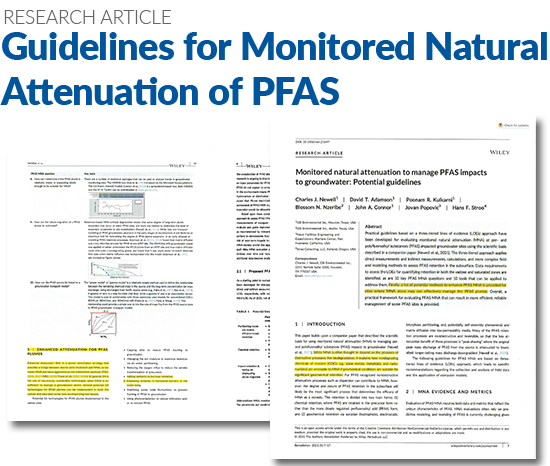This article by Charles J. Newell et al. published in Wiley's Remediation Journal discusses practical guidelines based on a three-tiered lines of evidence (LOE) approach for evaluating monitored natural attenuation (MNA) of PFAS. The approach outlined provides methods to assess PFAS retention in the subsurface. It also includes a list of methods to enhance MNA of PFAS plumes if MNA alone is not sufficient to manage the risk of the plume.
Highlights of this research article:
- Even without destructive processes like biodegradation, MNA can be a viable remedial strategy if conditions are suitable for retention
- Potential methods for assessing MNA of PFAS, including direct and indirect measurements of retention, and computer-based models
- Tools for “Enhanced Attenuation” (EA), including adding sorbents to increase retention and using sorbent barriers
To download the full article please complete the form on this page.
Technical Memo from REGENESIS CEO Scott Wilson Outlines "Key Takeaways" from the Article by Newell et. al. about MNA of PFAS
 Scott Wilson
President & CEO, REGENESIS
Below is a technical memorandum written by REGENESIS President & CEO Scott Wilson that summarizes what he sees as the "key takeaways" from this very important research paper by Charles Newell et. al. entitled “Monitored Natural Attenuation to Manage PFAS Impacts in Groundwater” (highlighted version of the article shared on this page). Key takeaways include a key concept that is intrinsic to environmental risk: Environmental Risk = Hazard X Exposure. By eliminating the potential for exposure, the risk is eliminated. This is how natural attenuation works. Download the technical memo written by Scott Wilson to learn more.
Scott Wilson
President & CEO, REGENESIS
Below is a technical memorandum written by REGENESIS President & CEO Scott Wilson that summarizes what he sees as the "key takeaways" from this very important research paper by Charles Newell et. al. entitled “Monitored Natural Attenuation to Manage PFAS Impacts in Groundwater” (highlighted version of the article shared on this page). Key takeaways include a key concept that is intrinsic to environmental risk: Environmental Risk = Hazard X Exposure. By eliminating the potential for exposure, the risk is eliminated. This is how natural attenuation works. Download the technical memo written by Scott Wilson to learn more.
Download the technical memo


